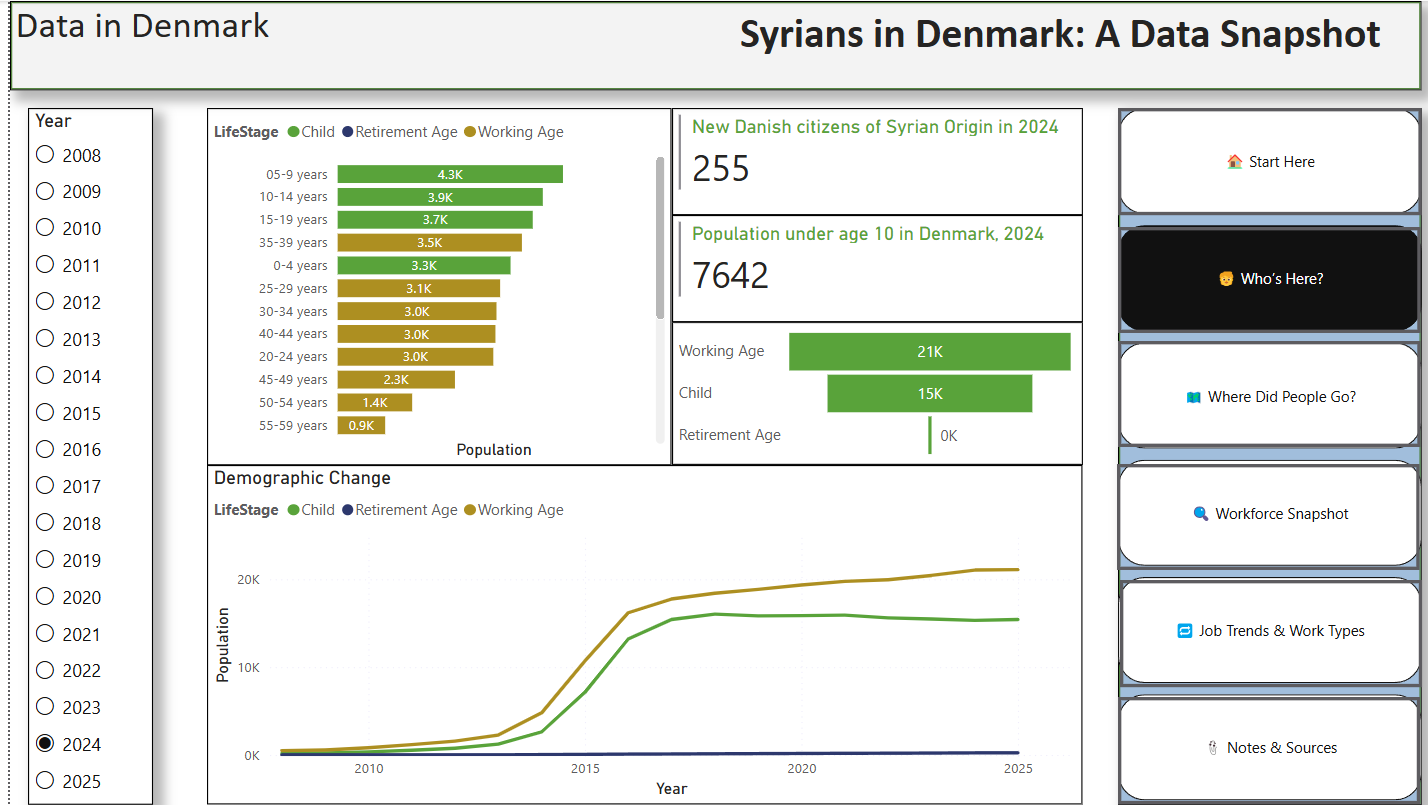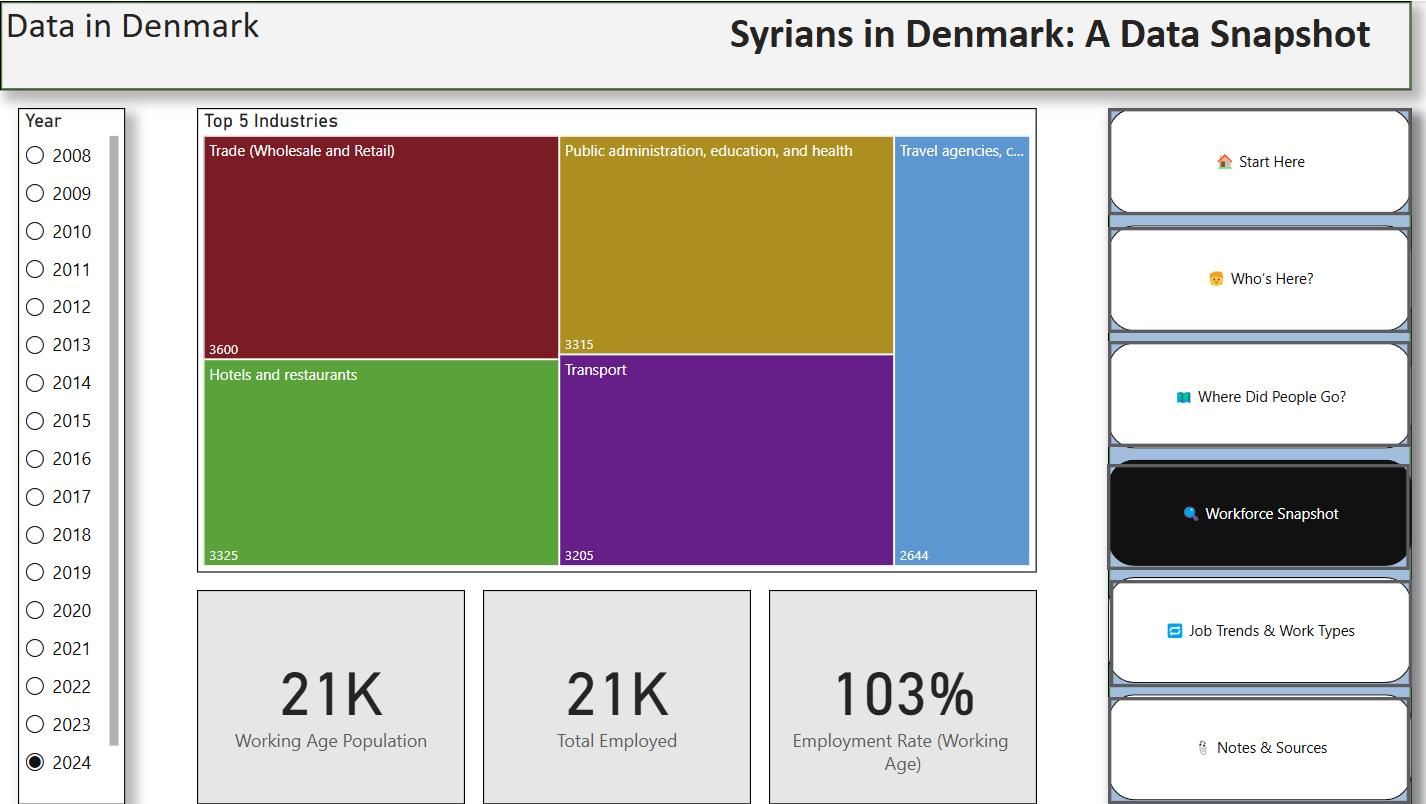Syrians in Denmark
A Power BI investigation into jobs, children, citizenship, and the politics of pretending Syrians are temporary.
The tyres of Assad’s getaway vehicle had not cooled down, and European politicians were calling for Syrian refugees and migrants to go back home.
Denmark froze asylum applications almost immediately, and prominent politicians such as the Immigration Minister Kaare Dybvad Beks (S) and the Prime Minister Mette Frederiksen (S) started calling for repatriation.
Lars Løkke Rasmussen (M), the Foreign Minister, said this was somewhat premature based on factors such as the sudden vacuum of power in Syria. The union 3F pointed out thousands of Syrians have full time jobs, that is to say Denmark would be pretty screwed if they all went home.
I have wanted to do a deep dive into the matter since December but the subject is so intricate and nuanced, I wanted to do it justice. Meanwhile, I have other stuff in my life like learning Power BI and making Power BI reports for my portfolio… and then it hit me: why not make a Power BI report into the ‘Syrian question’?
This is not an abstract question for me, full disclosure. Syrians are my neighbours and my previous colleagues. Syrian kids go to school with my kids. If you’re looking for a dispassionate analysis, you are well and truly in the wrong place.
If you want to access the Power BI yourself (and you should want that), you can download it from my GitHub page. Power BI dashboard software is free and Power BI really comes into its own when you click around. (Also, if you’re learning Power BI yourself you can look behind the scenes.)
Who was here in 2024
Some interesting things to look at here: in 2024, the biggest demographic group of Syrians was 0-4 year olds. The population of Syrians under 10, is over 7500. These are kids with no memory of Syria. These are kids who went to local folkeskoler not international schools, not schools that are allowed to teach all subjects in Arabic (because that doesn’t exist). If schools are the main way to transmit cultural values, that’s more than 7500 Danish children of Syrian heritage.
255 Syrians were awarded Danish citizenship last year. If you do not know how fricking hard it is to get Danish citizenship let me tell you: unbroken working history going back years, C1 Danish language skills and the general knowledge chops of a pub quiz master. Who did make My Rainbow Panorama in Aros? Plus a bunch of money to pay for the tests and for the application fee1.
These aren’t just Danish citizens on paper. These are people who earned it the hard way.
Where do they live?
Mostly Jylland! The top 15 kommuner are all in Jutland and Fyn. Aarhus alone has enjoyed a net migration of just over 800 Syrians since 20072.
Job Trends
Three line graphs but what do they mean?
Top graph: the dark blue line is the population of working age Syrians over time. The green line is how many of them have jobs3 in the top five industries.
The top five industries over the time period are hotels & restaurants, manufacturing, public sector (health and education), trade, cleaning & other. You know, jobs Denmark has trouble recruiting for.
The bottom line chart is the types of work permits being used by Syrians who are working. The increase in family reunification and permanent residency significantly unlocked the employment of Syrians in Denmark. You can also see that people are almost certainly working more than one job4 .
Workforce Snapshot (2024)
Here is a way of seeing which are the top five industries in 2024: hotels & restaurants, transport, public sector (health and education), trade, cleaning & other, and how many people have jobs in these sectors.
The working age population is around 21K and the total number of Syrians with some sort of job is also around 21K. The article from 3F, linked above, said about 9k have full time jobs. What this over-100% employment rate could be is that a lot of people have more than one job. Or teenagers and retirees have a job. Or a mix of this.
I don’t know about you but if over 3000 workers disappeared from the education and health care sector, I would be pretty nervous. These people are infrastructure.
Editorialisation Times
There is a first time for everything but I agree with Lars Løkke Rasmussen on this: there are humanitarian grounds for not sending refugees back the very second their tyrant hides out in Moscow. Our obligations as a stable country that can shelter other humans from catastrophe are not contingent on their productivity.
But. But there are cold hard economic facts as well. There are some incredibly productive members of the Syrian community and we would be absolutely lost without them. If they want to stay, we in Denmark should feel absolutely honoured.
There are also some hard questions about immigration policy to answer. Children are not offered home language classes unless they come from an EU country. Friskoler have strict rules about teaching in Danish unless they have special dispensation to teach in another language5. The school have to satisfy the education ministry that the students are short-term stays. I don’t have stats on it but I think most Syrian children go to their local folkeskole or børnehave, anyway.
If the policy is going to be “once a country becomes stable, eject all refugees” then maybe children should be prepared for that with home language instruction at least. Ukrainian children were offered Ukrainian/Russian language instruction, for example, alongside Danish.
For me, it just seems so knee-jerk to run to the press with “they should bugger off immediately”. We need them. They are assets. We made them Danish. They are ours now. A little more nuance is necessary, rather than trying to appeal to the worst of human nature amongst the Danish electorate.
Oh and you have to shake someone’s hand, apparently the hardest step of all given the outsize importance granted to it.
Which explains why it is personal for me. This is my town we’re talking about. It might also explain why Copenhagen politicians are so quick to hit the ejector seat button.
Not necessarily full time jobs. More on this in a bit
Unless there’s another way of counting work permits that I didn’t count. Apologies in advance if that happened etc etc
The other languages are, of course, French, German and English.




